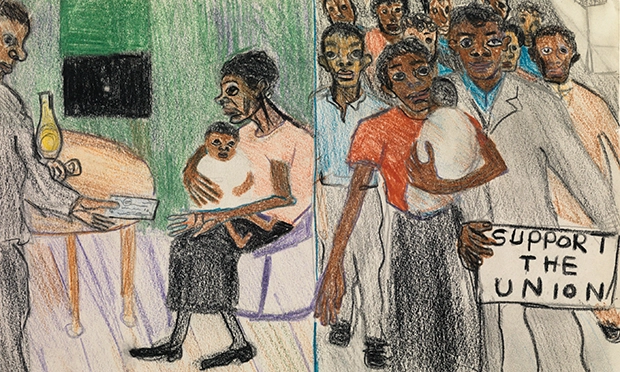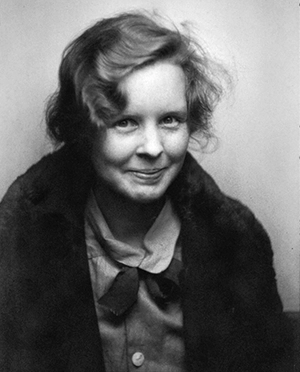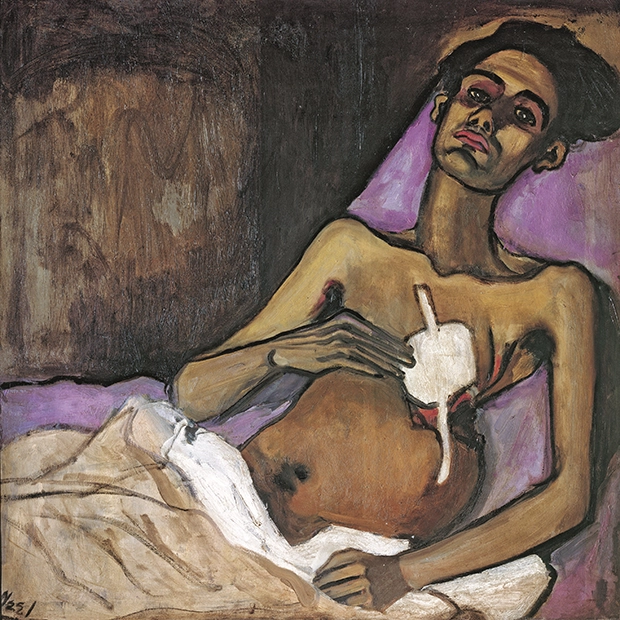Alice Neel: Hot Off The Griddle, Barbican, exhibition review: ‘The collector of souls will capture yours too’

Support the Union, 1937. Image: courtesy the Estate of Alice Neel
Born on January 28 1900, artist Alice Neel liked to say she was four weeks younger than the century.
She was also ahead of the curve in her socialist art philosophy, painting people who were not usually portrayed because of their race, status, sexuality or views.
The Barbican exhibition Hot Off The Griddle shows the awe-striking will and skill of an artist set on making a difference in a way that wasn’t fashionable at the time.
Neel’s pull to art was very much instinctive. She grew up in a small conservative town in Pennsylvania with little culture, and her mother rebuffed her dreams of becoming an artist.
“You’re only a girl,” she would say.

Alice Neel at the age of 29, 1929. Photograph: courtesy the Estate of Alice Neel
But Neel took off to Cuba to pursue her ambition, and began by painting passersby, inspired by the beautiful light and colours in the country.
After a nervous breakdown, she revived herself by capturing the beatnik community.
Her intimate portraits of friends captured the routine moments of life humorously, with pale cartoon-like bodies and arresting interiors.
Her figurative paintings challenged the fashion for abstraction.
The Great Depression in the 1930s inspired public arts projects, which employed artists like Neel and recognised art as labour. She was paid $26.88 weekly to create a 30-inch painting every six weeks.
As a member of the USA Communist party, she depicted protests, police brutality and adversity.
One picture in this section of the exhibition is of a magistrate’s court, painted from memory after she was arrested for picketing. The ominous shadows and lights falling on the court attendees’ faces perhaps reflect her anarchist views.
Neel also captured the American social climate, painting forlorn children playing next to a suited man who has collapsed while clutching a bottle.
The artist, who described herself as “the collector of souls”, moved to Harlem in the early 1940s with a nightclub owner. Her subsequent portraits of people in precarious situations are even more intimate in their emotions and detail than her earlier work.
In her diary, she wrote: “I love you Harlem for the rich deep vein of human feeling buried under your fire engines.”
Her work here was deeply political. Her painting of her ex-partner’s brother recovering from tuberculosis highlighted the New York epidemic caused by overcrowding.

T.B. Harlem, 1940. Image: courtesy the Estate of Alice Neel
Neel communicates well the hardship and trauma weighing on her subjects through distracted eyes or even a slump of the shoulders.
“East Harlem is like a battlefield of humanism, and I am on the side of the people here,” she said.
Some of Neel’s other studies helped to bring public attention to individual cases of injustice. In her painting of protesters outraged by the rape conviction of Black grocery driver Willie McGee, the eerie high contrast colours and slanted buildings evoke serious tension.
In her last decades of life, she saw a new wave of recognition from critics, while celebrities sought her out for portraits, including Andy Warhol and poets like Frank O’Hara. They were drawn to being portrayed in emotional raw style.
But Neel’s humanist instinct continued. She still looked for subjects with traumatic stories, even if it meant exclaiming to strangers across the park.
Her personal life is covered comprehensively in the exhibition – full of partners, children, encounters and cultural phenomena.
Like Neel’s art, the exhibition really makes you feel familiarity with its subject.
It finishes with a video montage that showcases Neel’s exuberance as she paints her amused subjects, flashes cheeky grins, and plants kisses on friends.
This exhibition will affect and enchant anyone – art history buff or not.
Alice Neel: Hot Off The Griddle runs until 21 May at the Barbican.
For more information, visit barbican.org.uk.
